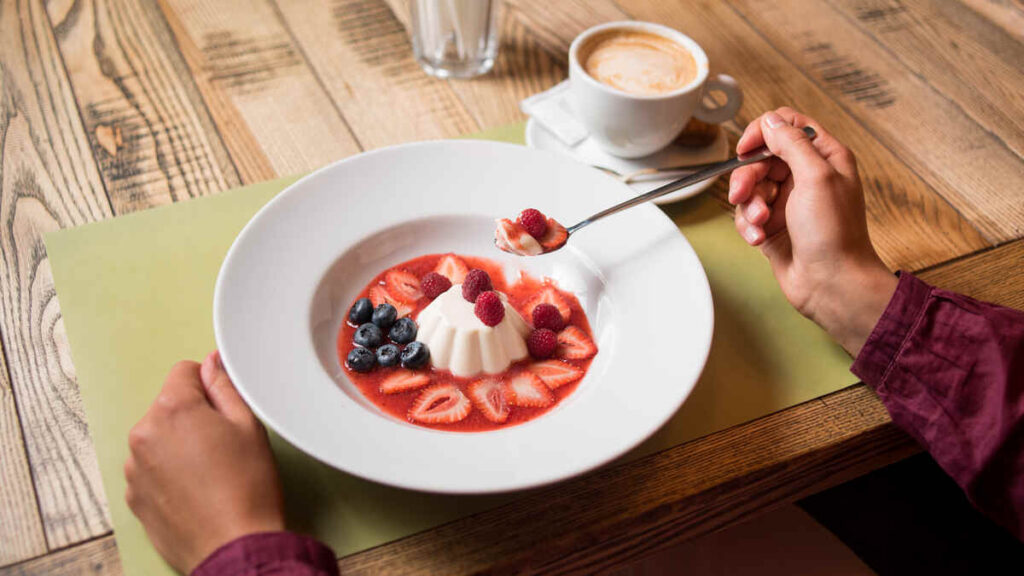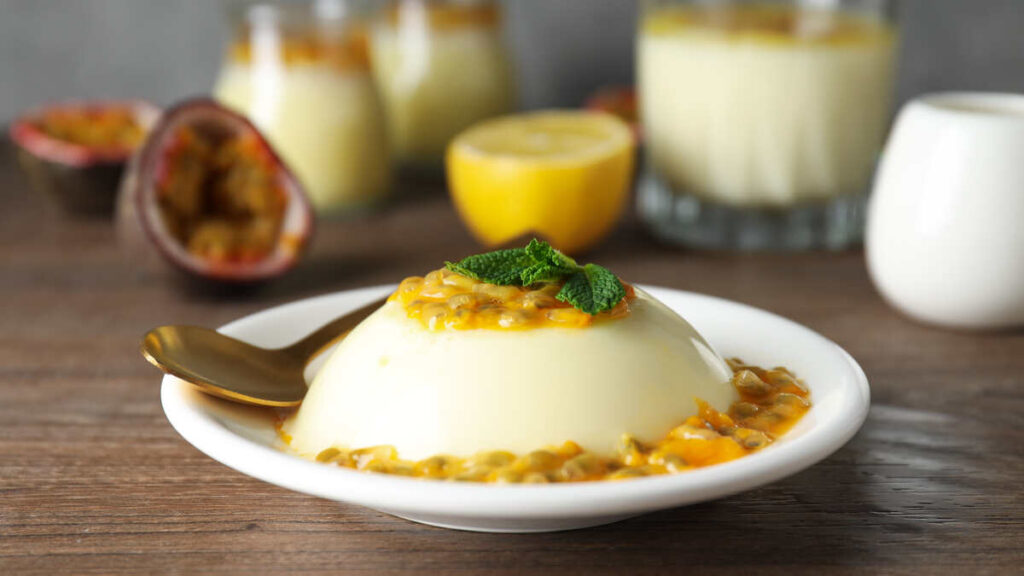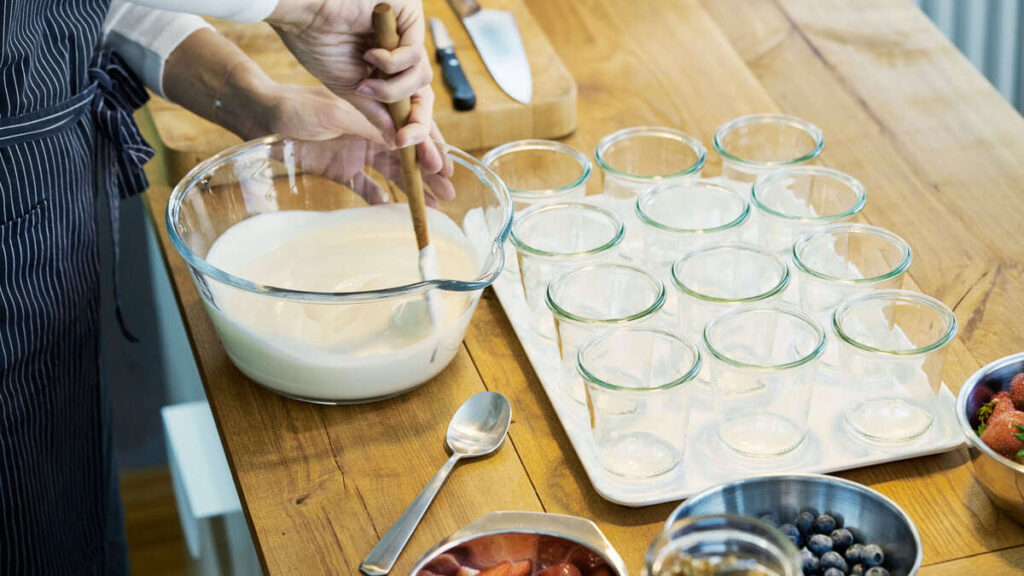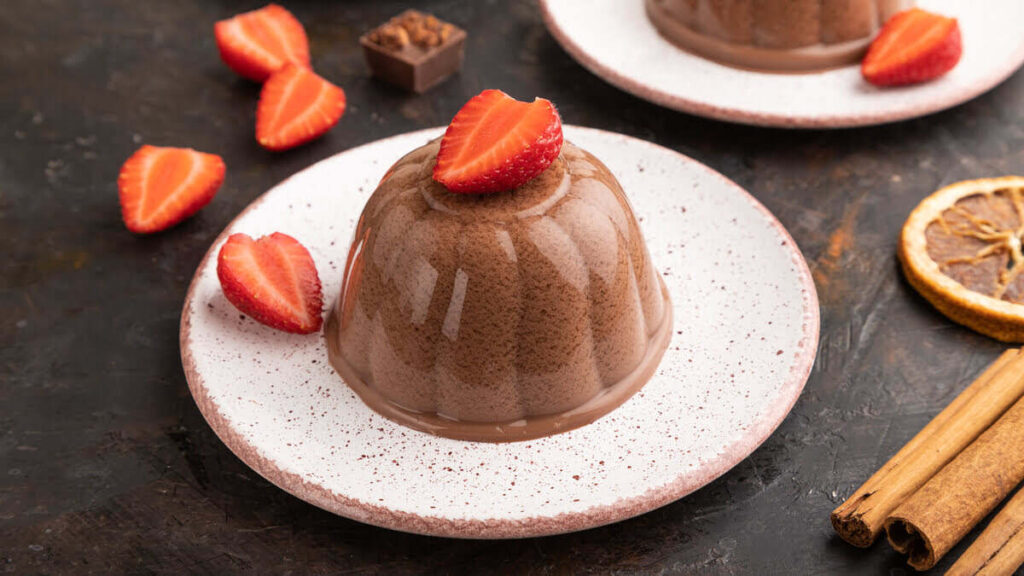
When it comes to classic Italian desserts, panna cotta undoubtedly takes its place at the forefront. This velvety speciality is a harmonious blend of simplicity and sophistication that has been winning the palates of sweet lovers around the world for years. What makes this delicacy so special?
The Italian culinary tradition is based on the idea that the best desserts not only please the palate, but also improve the mood. Panna cotta is a perfect example of this premise – whether you enjoy it in a cosy trattoria in the heart of Tuscany or at your own table, its taste is a true feast for the senses. And the best part? Preparing this unique dessert at home is much easier than you might think!
What is panna cotta?
Panna cotta is a classic Italian dessert with a velvety texture, whose name literally means “boiled cream”. Although its exact origins are shrouded in mystery, it is assumed that it was first created in the Piedmont region in the early 20th century. It is a simple yet elegant option for lovers of subtle flavours, which delights with its lightness and creamy texture.
The basic ingredients of panna cotta are cream, sugar and gelatin, which gives the dessert the right consistency. The whole is usually enriched with aromatic additives such as vanilla, chocolate, cinnamon or liqueurs, which are responsible for the special character of this delicacy. The preparation process is uncomplicated – the warmed cream, combined with sugar and the chosen flavouring, is mixed with pre-soaked gelatin, then poured into moulds and cooled to take on the perfect consistency.
Panna cotta is extremely versatile – it can be served solo or accompanied by fruit sauces, caramel, nutty crumble or fresh fruit, making it a dessert that can easily be adapted to individual tastes.
History of panna cotta
One theory is that panna cotta was created in the early 20th century by a woman of Hungarian origin living in the Langhe region of Piedmont.
At the time, access to modern gelling agents was limited, so natural thickeners, including fish bone broth, were used to give the dessert the right consistency. The traditional recipe was mainly based on full-fat cream, which took on a characteristic creamy texture when cooled. Italians have valued dairy desserts for years, and panna cotta quickly gained recognition as an elegant and versatile end-of-meal option.

However, some sources indicate that similar desserts existed in Europe much earlier, and that panna cotta may have been just a modern interpretation of old recipes. For example, in 13th-century Denmark, a dessert called “hwit moos”, which was made from milk, sugar and natural thickeners, was popular. Its velvety texture and subtle sweetness were reminiscent of modern panna cotta, suggesting that the inspiration for the Italian speciality may have come from different parts of the continent.
Popularisation of panna cotta
Interestingly, the very name “panna cotta” did not appear in Italian cookbooks until the 60s of the 20th century. It was then that Ettore Songia, chef of a renowned restaurant, decided to introduce this dessert to his menu, giving it a contemporary form and popularising it among a wider audience. From then on, panna cotta began to gain recognition not only in Italy, but also in the rest of the globe. Thanks to its simplicity and the possibility of various modifications, it became one of the most recognisable Italian desserts, which is still found in restaurants and many home kitchens today.
Panna cotta | Recipes
Panna cotta is a dessert that delights with its simplicity while offering endless possibilities for modification. The classic version based on cream and vanilla is just the starting point – with a variety of additions and flavours, you can create extremely diverse variations of this Italian delicacy. Whether you prefer classic flavours, fruity accents or modern interpretations, below you will find recipes that will allow you to prepare the perfect panna cotta in your own kitchen.
Classic panna cotta – recipe
Panna cotta in its traditional version is the essence of Italian simplicity and elegance. It is prepared with just a few basic ingredients and the end result impresses with its velvety texture and subtle vanilla flavour. The recipe below will allow you to create a perfectly creamy dessert that pairs perfectly with fruit sauces, caramel or chocolate.
Ingredients (for 4 portions):
- 200 ml of whole milk
- 200 ml of 30% cream
- 50 g of vanilla sugar or 4 tablespoons of sugar + vanilla extract
- 2 flat tbsp of gelatin (approx. 14 g)
- 50 ml of cold water
Preparation:
- Preparing the gelatin
Place the gelatin in a small bowl, pour over cold water and set aside for a few minutes to swell. - Heating the ingredients
In a saucepan, combine the milk, cream and vanilla sugar (or plain sugar with vanilla essence). Heat over a low heat, stirring regularly, until the sugar has completely dissolved. When the mixture starts to boil slightly, take it off the burner. - Combining with gelatin
Add the swollen gelatin to the hot, but not boiling, mixture. Stir thoroughly until the gelatin has completely dissolved, forming a uniform, smooth consistency. - Pouring and cooling
Prepare the moulds or cocktail pans, rinse them with cold water and then pour the prepared mixture into them. Place the dessert in the fridge and leave to set for at least 2-3 hours.
After this time, the panna cotta should have a perfectly firm but soft texture. You can serve it straight from the moulds or gently remove it to a plate, serving with your favourite toppings such as fruit, raspberry sauce or caramel.
Chocolate panna cotta – recipe
Chocolate panna cotta is an exquisite version of the classic Italian dessert, in which the intense flavour of dark chocolate blends perfectly with the velvety texture of the cream base. It is an excellent choice for lovers of deep chocolate notes and elegant dessert compositions. It tastes great both on its own and with additions.
Ingredients (for 6 portions):
- 500 ml of 30% cream (chilled)
- 150 ml of full fat milk
- 110 g of sugar
- 200 g of finely chopped dark chocolate (min. 70-80% cocoa)
- 10 g of gelatin
- 50 ml of cold water
Preparation:
- Preparing the gelatin
In a small bowl, pour 50 ml of cold water over the gelatin and set aside for a few minutes until it swells. - Heating the chocolate base
In a saucepan, combine 300 ml of cream, milk, sugar and chopped chocolate. Heat over a low heat, stirring occasionally, until the chocolate has completely melted and the mixture is homogeneous. Do not bring to the boil. - Adding the gelatin
Remove the pot from the heat and add the swollen gelatin to the mixture. Stir thoroughly so that it dissolves completely. Allow the mixture to cool. - Whipping the cream
In a separate bowl, whip the remaining 200 ml of chilled cream until fluffy but not too stiff. Then gently stir it into the cooled chocolate mixture, combining the ingredients to a smooth consistency. - Refrigerating the dessert
Pour the prepared mixture into moulds or cups. Place in the fridge and leave to chill for at least 2 hours to give the panna cotta the right consistency. - Serving and garnishing
Before serving, decorate the dessert with grated dark chocolate and fresh fruit, such as pomegranate seeds.
This intensely chocolaty version of panna cotta is the perfect way to end an elegant dinner party or a gathering with friends. It tastes delicious both in its classic form and combined with your favourite toppings.
Exotic panna cotta – recipe
Exotic panna cotta is for those who like classic desserts in a modern, tropical edition. The combination of the creamy texture of the cream with mango and passion fruit gives the dessert a unique, slightly refreshing taste. It is an excellent choice especially for summer parties.
Ingredients (for 4 larger portions):
- 500 ml of 36% cream
- 1 vanilla pod (or 1 teaspoon of vanilla paste)
- 80 g of sugar
- ¼ teaspoon of fine sea salt
- 1 cup (230 g) of Greek yoghurt or cream yoghurt
- 3.5 teaspoons of gelatin powder
- 4 tbsp of cold water
- 250 ml of mango pulp (canned or fresh fruit)
- 2 passion fruit
- 40 g of milk chocolate, finely chopped

Preparation:
- Heating the cream
In a medium saucepan, combine the cream with the sugar, salt and the seeds hollowed out of the vanilla stick. Heat over low heat, stirring until the sugar has dissolved. Remove the mixture from the burner. Add the yoghurt and stir gently to achieve a smooth consistency. - Preparing the gelatin
In a separate bowl, pour 4 tablespoons of cold water over the gelatin and leave it to swell for about 10 minutes. Then gently heat it over a low heat, stirring until it is completely dissolved – remember not to boil it as it will lose its gelling properties. - Combining the ingredients
Add the dissolved and warmed gelatin to the slightly cooled cream mixture, stirring constantly with a whisk to distribute evenly. Set aside for a few minutes to allow the mixture to thicken slightly. - Preparing the fruit topping
In a separate bowl, mix the mango pulp with the passion fruit pulp and the chopped milk chocolate. - Layering the mixture
Lightly grease the inside of four bowls or moulds with vegetable oil. Pour just over half of the cream mixture into two of them. Add ⅔ of the prepared fruit sauce to the remainder and mix thoroughly. Fill another two moulds with the mixture. - Cooling
Place the dessert in the fridge for at least 4 hours, or preferably overnight, to give the panna cotta the perfect consistency. - Serving
To make it easier to remove the dessert from the moulds, dip them in hot water for a few seconds before gently inverting them onto a plate. Serve the white panna cotta with the remaining mango-passion fruit sauce, which will further emphasise the exotic character of the dessert.
Unlike the classic panna cotta, this version uses yoghurt that is not heated. To ensure that the ingredients are evenly combined and to avoid lumps, it is necessary to dissolve the gelatin in warm water beforehand. This gives the panna cotta a perfectly smooth texture and its exotic flavour remains consistently velvety.
Vegan panna cotta – recipe
A vegan version of panna cotta is the perfect alternative to the traditional Italian dessert. Thanks to the use of plant milk and agar, which appears in the recipe as a substitute for gelatin, the dessert retains its velvety texture and delicate flavour. Vegan panna cotta is not only light and healthy, but also easy to prepare – ideal for those avoiding animal products or looking for a lighter version of the classic recipe.
Ingredients (for 2-3 portions):
- 2 cups of plant milk (almond, coconut or nut milk)
- 1 teaspoon of agar-agar
- 2 teaspoons of agave syrup, erythrol, xylitol or other natural sweetener
- 2 teaspoons of vanilla extract
- 1 teaspoon of tapioca or potato starch
Preparation:
- Heating the base
Pour 1¾ cups of plant milk into a saucepan, add the sweetener, agar-agar and vanilla extract. Stir the whole mixture thoroughly and heat over medium heat, bringing to a boil. Once boiling, cook for 2 minutes, stirring constantly so that the agar dissolves and activates well. - Adding the starch
In a separate bowl, mix ¼ cup of milk with the potato or tapioca starch so that there are no lumps. Slowly pour the mixture into the boiling milk and stir vigorously so that the mixture becomes smooth and homogeneous. Continue to cook for a few seconds until it thickens slightly. - Preparing the moulds
Grease a small bowl or mold with a thin layer of neutral flavoured vegetable oil – this makes it easier to remove the dessert once it has cooled. - Cooling
Pour the hot mixture into the prepared tins and leave to cool at room temperature. Then place in the fridge for at least 3 hours to allow the panna cotta to set well. - Serving
To remove the dessert easily, dip the moulds in hot water for a few seconds, then gently lift with a knife and transfer to a plate. Vegan panna cotta tastes great with fruit mousse, fresh fruit or a nutty topping.

Thanks to the use of plant-based ingredients, this light and creamy dessert delights with its flavour and will work as an everyday sweet snack as well as an elegant accompaniment for special occasions.
Strawberry panna cotta mousse – recipe
The slightly sour, intensely fruity strawberry mousse is the perfect complement to the velvety panna cotta. Its freshness and delicate sweetness contrast perfectly with the creamy texture of the dessert, creating a harmonious composition of flavours. It can be prepared not only with fresh but also frozen strawberries, making it pleasing to the palate at any time of the year.
Ingredients:
- 500 g of strawberries (fresh or frozen)
- 1 packet of strawberry jelly
- 150 ml of hot water
- Optional: 1-2 tbsp of sugar
- Optional: 1 tbsp of lemon juice
Preparation:
- Cooking the strawberries
Wash the strawberries, remove the stalks from them and then place them in a saucepan. If you’re using frozen fruit, don’t defrost them beforehand – just drop them directly into the pot. Add a splash of water and simmer over a low heat for a few minutes until the strawberries are soft and have released their juice. - Blending
Remove the pot from the burner and use a blender to blend the strawberries into a smooth mousse. If you want a clearer texture, you can also press the mousse through a sieve to get rid of the seeds. - Adding the jelly
In a separate bowl, dissolve the strawberry jelly in 150 ml of hot water, stirring well until completely dissolved. Then add it to the hot strawberry mousse and stir again to get a uniform consistency. - Cooling
Set the finished mousse aside to cool. When it has reached room temperature, you can pour it over the cooled panna cotta or place it in the fridge to thicken slightly before serving.
Strawberry mousse is the perfect accompaniment to panna cotta, but it will work just as well on other desserts such as ice cream, pancakes or cakes. The tasty topping can also be made with other fruits such as raspberries, blueberries or mango – simply substitute strawberries in the recipe and choose the right jelly for an equally tasty and flavoursome result.
How many calories does panna cotta have?
The calorific value of panna cotta depends on its composition, especially the cream used, the amount of sugar and the additives. Below are indicative values for different variations of this dessert, converted per 100 g.
Calorific value of different types of panna cotta (per 100 g):
- Classic panna cotta (30% cream, milk, sugar, gelatin) – approx 205 kcal
- Chocolate panna cotta (extra dark chocolate) – approx. 349 kcal
- Panna cotta with strawberry mousse – approximately 179 kcal (weight calculated with a ratio of 70% classic panna cotta and 30% mousse)
- Vegan panna cotta (plant milk, agar, natural sweeteners) – approx. 125 kcal
How to reduce the calorific value of panna cotta?
Reducing the calorific value of panna cotta is possible without losing its unique flavour. A key step is to replace the cream with less calorific alternatives such as plant milk (e.g. almond milk, oat milk) or Greek yoghurt. This way, the dessert retains its creaminess but contains less fat. In addition, by forgoing sugar in favour of natural sweeteners such as erythritol, xylitol or maple syrup, the energy value of the prepared dessert can be significantly reduced.
Another effective method is to choose lighter toppings. Instead of chocolate or caramel, opt for fresh fruit or strawberry mousse, which add variety to the flavour, but without excessive calories.
The perfect panna cotta | Tips
To ensure that panna cotta has a perfectly creamy texture and delicate flavour, it is worth paying attention to a few key aspects when preparing it. Although it is a simple dessert to make, small details can make a significant difference to its final quality.
Dissolving the gelatin properly
The gelatin should be soaked in cold water and then added to hot, but not boiling, cream. Too high a temperature can weaken its gelling properties, and inaccurate dissolution will result in lumps in the dessert. For the vegan version, it is worth remembering that agar-agar requires a short boil to set properly.
The right proportion of ingredients
Too much gelatin will make the panna cotta hard, while a deficiency will mean that the dessert will not set properly. The optimum ratio is about 7 g of gelatin per 500 ml of liquid. The plant-based version should use about 1 teaspoon of agar-agar per 500 ml of liquid, adjusting the amount according to the desired consistency.
Chilling without rushing
Panna cotta requires adequate time to set – a minimum of 2 hours in the fridge and preferably overnight. It’s also worth avoiding putting it in the freezer, as this can affect its texture and make it grainy.
Easy removal from the moulds
To make sure the dessert comes out of the mould easily, you can lightly moisten the mould with water or grease it with neutral flavoured oil before pouring in the mixture. Before removing the panna cotta, it is a good idea to dip the mold in warm water for a few seconds and gently scrape the edges with a knife.
Perfect toppings
Panna cotta goes well with fruit mousses, nuts, chocolate or caramel. However, it is worth bearing in mind that heavy toppings can overwhelm the delicate flavour of the dessert, so it is best to choose light and fresh toppings to accentuate its velvety texture.

By following these tips, you are sure to prepare a panna cotta with a perfect texture that will delight your guests with both taste and appearance. Enjoy!



